Nature Notes
by Bob Thomas
Niche partitioning is a fun term that has a range of nuances to its meaning. Here we will use it to simply illustrate how several backyard species use the same food resources yet are able to live in the same general area because they feed at different times of the day. Evolutionary ecologists may use the term to suggest that niche partitioning is a concept that may force natural selection (with the ultimate result of forming new species) by allowing them to remain separate in the same ecological zone by partitioning their use of their environment. Examples may include occupying different places in the habitat, feeding at different times, being active at different times of the year, etc.
Niche partitioning sounds exotic, so it must happen in the tropics, right? It does, but it also happens locally in our backyards.
I used to keep my garbage can on the side of my house beside a large ligustrum bush. When I emptied my indoor trash cans into my outside garbage can during the day, I often noted honey bees swarming the flowers collecting nectar.
One evening I was emptying my trashcans and I heard the familiar buzzing sound. Surprised that bees were that active in the dark, I got a flashlight and found the same flowers being harvested by several varieties of moths.
I often use this in my classes as an example of different species sharing the same resources by niche partitioning. In this case, bees and moths used the same food resources, but they partitioned (separated) the niche (gathering nectar from flowers) by the bees being diurnal (active by day) and the moths being nocturnal (active in the evening).
This is common in nature and there are numerous examples in our area.
One example that I watch in my yard is my flowering buttonbush (Cephalanthus occidentalis). The flowers are delicate in structure and look like little satellites. Strange to me is that they are the feeding sites of (and pollinated by) our largest bee, the bumblebee. Close inspection, however, reveals many species of nectar- and pollen-feeding insects, as well as their predators. At night, of course, there is a whole new battery of critters, including moths, mosquitoes, and other nectivorous insects, at the feeding table.
A common vertebrate example includes niche partitioning between green anoles (Anolis carolinensis) and Mediterranean geckos (Hemidactylus turcicus). "Chameleons," as many call anoles here, are active during daylight, feeding on just about anything that fits into their mouths. In the evening, the geckos are active doing the same, but feeding on nocturnal insects such as moths, lacewings, termites (ugh!), and the like. Both lizards are active all over my yard, but the anoles are most common on bushes where they blend with the background, and geckos are most active on walls and window screens. They thrive around lighted areas that attract nocturnal insects.
Keep your eyes pealed. Examples of niche partitioning abound.
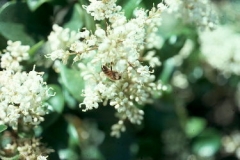
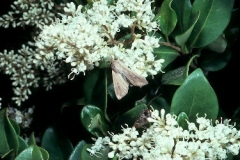
Bees swarming about on ligustrum Moths on the same ligustrum at night.
during the day. Photo by Bob Thomas.
Photo by Bob Thomas.
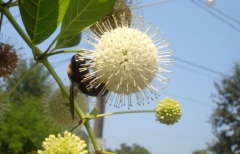
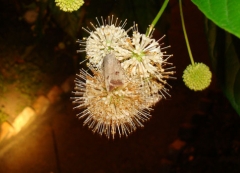
Bumblebee on a buttonbush flower. A moth on the same buttonbush plant
Photo by Bob Thomas. at night.
Photo by Bob Thomas.
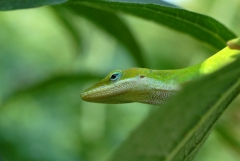
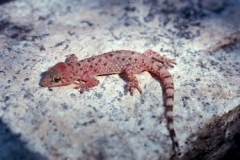
Green anole searching for insects in the Mediterranean geckos love to feed on
foliage. moths in the evenings on window screens.
Photo by Shannon Fortenberry. Photo by Bob Thomas.